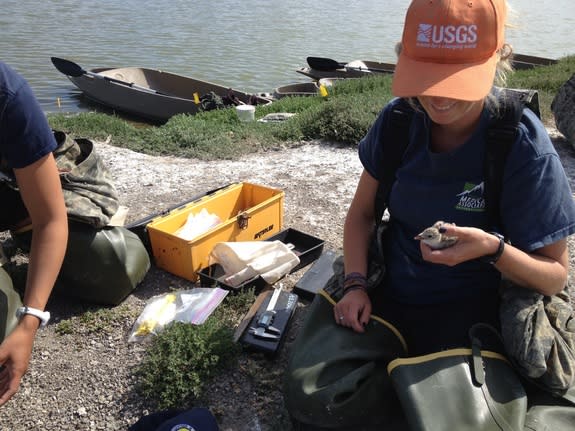Shorebirds Adopt Baby Duckling, Cuteness Ensues
A family of long-legged shorebirds adopted a fuzzy baby duckling this month in California's San Francisco Bay.
U.S. Geological Survey (USGS) biologist Jarred Barr discovered the duckling among a brood of downy avocet chicks on July 2. "It was just following right behind the adult avocet and chicks like it was another avocet," Barr told Live Science.
The blended family was foraging in wetlands at the Eden Landing Ecological Reserve, part of the massive South Bay Salt Ponds Restoration Project. Barr found four avocet chicks and the mallard duckling, each just a few days old, plus two avocet parents. "We don't know how the duckling got separated from its family, but they were all feeding already and copying the adults," he said. [See Adorable Photos of the Baby Shorebirds]
Avocets have long, upturned bills that they skim back and forth in the water to catch food. The tallest of the world's four avocet species — growing up to 20 inches (51 centimeters) tall — the avocet is equipped with spindly gray legs designed for wading in fresh or saltwater wetlands.
Bird watchers
Barr helps monitor mercury levels in avocets and other shorebirds at marshes and ponds throughout the salt ponds restoration project. The enormous 30-year effort, one of the country's largest wetlands rebuilding projects, will add much-needed wetlands habitat in the San Francisco Bay, but it also may stir up toxic metals such as mercury. The San Francisco Bay is contaminated with mercury due to mining in California's mountains starting in the 1800s. River and streams funneled the mercury to the bay.
"It's a massive undertaking that's going to lead to some pretty significant changes in the environment, and it's really important for us to monitor these birds and see how they're reacting," said Alex Hartman, a USGS wildlife biologist at the Western Ecological Research Center in Dixon, California, who helps oversee the shorebird-monitoring project.
Plucking a few feathers from shorebird hatchlings reveals how much mercury was in their eggs before they hatched. Barr and his colleagues also measure and weigh the chicks.
The researchers track the health of American avocets, black-necked stilts and Forster's terns, among other birds.
The biologists occasionally find eggs from other species, such as terns, in avocet nests, Hartman said. And it's not uncommon for avocets to adopt chicks from other avocets, Hartman said. Avocets have also sat on stilt eggs and raised the hatchlings as if they were their own chicks. But this is the first time the USGS biologists have discovered a duck-avocet adoption.
Hartman thinks it's likely the duckling was separated from its family after it hatched, and glommed on to the avocets.
"This is cross-species, and it's really cross-order. It's pretty unique," Hartman said. "They have different diets and different foraging modes, so a duckling would really be better off raised by other ducks."
Barr felt the same, and after spotting a mallard family a few ponds over from the avocet-duck flock, he went back for the duckling … but it couldn't be found again.
"Our plans fell through, but we didn't want to disturb the birds any further," he said. "When in doubt, in my mind, the best thing is to leave something be."
Hartman said he agrees. "The birds got themselves into this situation. For the most part, we just let nature take its course, and the birds can sort themselves out."
Both ducklings and avocets are resourceful babies, however, with the capability to feed on their own soon after hatching. As long as the duckling finds the right food sources and the right habitat, it could survive on its own, the scientists said.
"It's anybody's guess what will happen to it," Hartman said.
Email Becky Oskin or follow her @beckyoskin. Follow us @livescience, Facebook & Google+. Original article on Live Science.
Copyright 2014 LiveScience, a TechMediaNetwork company. All rights reserved. This material may not be published, broadcast, rewritten or redistributed.




